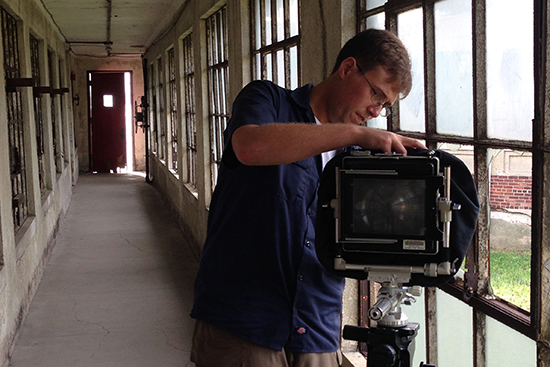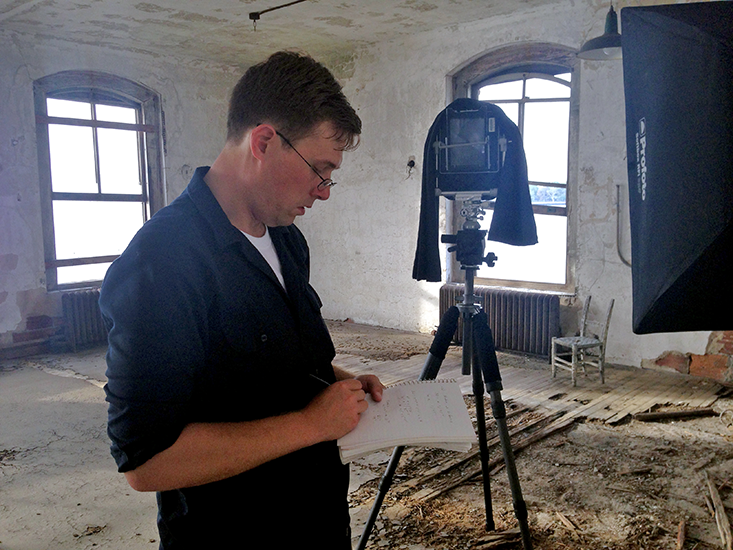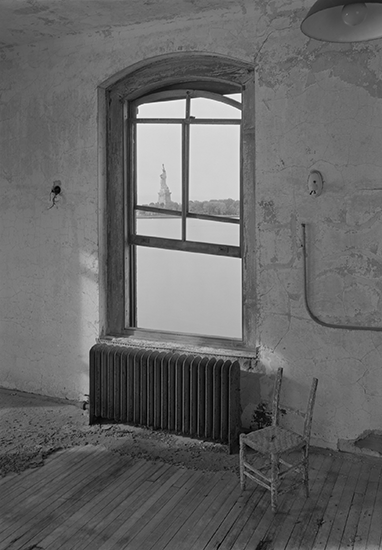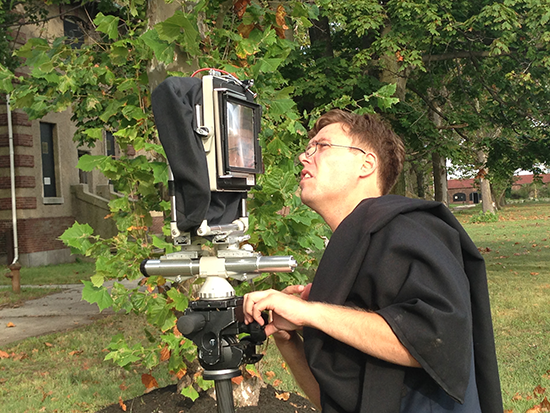
Jarob Ortiz was selected from a pool of nearly 5,000 candidates for the prestigious National Park Service photography position. (All photos of Jarob Ortiz were taken by Robert Arzola.)
While enrolled in MATC's photography associate degree program, Jarob Ortiz was consumed with photographing the ruins of abandoned steel mills and manufacturing sites using special equipment rarely used these days – a large format view camera. The marriage of skill, passion and ability to use the "Zone System" developed by legendary photographer Ansel Adams led Ortiz to a stunning achievement last summer. He was chosen from a field of nearly 5,000 applicants for a prestigious job as a National Park Service photographer.
"I couldn’t believe it when they told me I had the job," Ortiz said. “I broke down and wept. I always do my best. I tried my hardest, but I never thought I'd land this job. It’s a dream job for me. I will never leave.”
Working for the National Park Service's Heritage Documentation Programs, Ortiz travels the country using film and light to capture images of buildings, engineering and sites of historical significance that will be preserved in the Library of Congress.
The job was advertised and widely touted in national media as being “Ansel Adams' job,” but Ortiz explained that what he is doing is different. Adams used the Zone System he developed with Fred Archer, and used the large format view camera, but he was a contractor hired by the Secretary of the Interior to photograph scenery and landscapes for the National Park Service. Ortiz uses the same photographic techniques and type of camera, but his main focus is on creating black-and-white photos that will live on as historical records of sites, some of which may soon be demolished or renovated.
Credits MATC Instructors for His Success
Ortiz is quick to credit Milwaukee Area Technical College's photography associate degree program and instructors John Glembin, Mark Saxon and the late Duane Manthei for his success. Manthei taught him the Zone System, which uses mathematical calculations in zones of the photo to best capture light to evoke emotion in the viewer and to capture detail.
"I give my MATC instructors the most credit," Ortiz said. "This wouldn't be possible without everything they taught me. They were a tough group of instructors. When you messed up, they let you know. I appreciated that." Ortiz graduated from MATC’s photography program in 2013.

Ortiz is shown making exposure calculations before taking the photo below.

The photo shows the view of the Statue of Liberty from a window in the Isolation Ward at Ellis Island.
Ortiz's story also was featured Jan. 20, 2017 on Milwaukee PBS' new show "10thirtysix." Here's a link to the story. https://youtu.be/SMW7ZCXtQSk?t=956
Glembin, who keeps in contact with Ortiz, remembers Ortiz as a student. "He was a 'hungry kid,'" Glembin said. "He always wanted to learn more, to perfect his skills. He was constantly calling to see if he could squeeze in extra time in the lab. He was meticulous. Jarob was very careful to record information correctly and be faithful to his subject matter." Ortiz's skills and dedication to documenting history make him perfect for the job, according to Glembin.
"To some degree, I'm envious," Glembin said. "If I were 33, I would love to do what he is doing. As an instructor, this is what you get into teaching for. It’s not for the paycheck. We want to pass on what we know to the students. We always want to help them get good jobs and make successful careers. To date, Jarob has made the biggest leap among my students."
Ortiz gained his fascination with city architecture as a youth. His father, who was a Milwaukee police detective, took Jarob and his brother Nate to see old building sites in Milwaukee. Among the places they visited were Jones Island and the Menomonee Valley. Years later, Jarob's stepfather introduced Jarob to photography by buying him his first camera, an OM-2 35 mm.
Obsession with Photography Began in 2009
“As soon as I started taking photos in 2009, it was over,” Ortiz said. “I lost touch with all my friends. It was all about photography. I was at it every day and night.”
After serving a six-year stint in the Air Force as an electronic warfare journeyman, Ortiz moved California for a job that was eliminated due to budget problems. In those days, Ortiz was barely scraping by financially, but he scrimped and saved enough to purchase one roll of film and have it developed each week.
As funding for his California job fizzled, Ortiz's passion for photography grew. He returned to Wisconsin where his brother's interest in photography was deepening as well. The two began documenting the ruins of steel mills and hotels in Gary, Ind., "just because it needed to be done," Jarob said. "No one paid us to do that."
I consider this a service to my country. I'm recording this so future generations can see what we had at this time. Every photograph is a reference for the future. My legacy is in the work and what I leave behind. No amount of money could substitute for the feeling I get doing this work.
Ortiz explained, "Gary represents so much of what this country was at one point. It had the largest steel mills in the United States. The city revolved around that. Milwaukee and Detroit were in a similar situation with manufacturing. We photographed sites in those cities to document that time in history."
Nate began taking photography classes at Madison College (formerly called Madison Area Technical College). Jarob was intrigued, but wanted to learn photography using the large format view camera. The camera is like the one used in the earliest days of photography. "It has a front board, a back standard and you can move it like an accordion. I use 4” x 5” film. It gives you so much control of perspective and allows you to adjust the focal plane," Ortiz said.
Drawn to MATC’s Unique Photography Curriculum
"I came to Milwaukee Area Technical College's program in 2010 because it still taught the use of the large format camera, in addition to digital cameras," Ortiz said. "The only other way I could have studied that camera would have been to go to a $40,000-a-year art school."
While most of today's photography is accomplished with digital cameras, there is a niche of photographers using the large format cameras. "The resolution is so much better with film," Ortiz explained. "Resolution is what counts. No other kind of camera can get that resolution. The native file has more tonal range, a clearer image.”
Glembin said that it is important to note that well-archived and properly processed film will last a very long time. “We still have photos taken with the first film used in the 1800s," Glembin said. "We don't know how photos taken in the digital format will last over time. Will the disks survive? As computers continually change and evolve, will we always be able to open those files?" The superior resolution and the durability of film make it the right medium for use for historical purposes by the Library of Congress, he said.

Ortiz photographs buildings, engineering and places of historical significance for the National Park Service's Heritage Documentation Programs. He is shown here photographing Ellis Island.
Preserving History for Future Generations
Recently, Jim Axelrod of “CBS This Morning” joined Ortiz as he photographed areas of Ellis Island, including the dormitories and baggage rooms used long ago by immigrants. Ortiz was moved by imagining what immigrants must have been feeling and what they experienced. "It inspires me to do the best I can because I think it's important that these stories get told," Ortiz told Axelrod. See the “CBS This Morning” feature at: http://tinyurl.com/jovwmv8.
Ortiz works more than 60 hours a week, traveling from site to site, documenting scenes before they are lost to history. "I consider this a service to my country," he said. "I'm recording this so future generations can see what we had at this time. Every photograph is a reference for the future. My legacy is in the work and what I leave behind. No amount of money could substitute for the feeling I get doing this work."
See a gallery of Jarob Ortiz’s photos at http://marketing.matc.edu/web/photos/20161220_JarobOrtiz/
For more information on MATC’s photography associate degree program, visit: http://www.matc.edu/media_creative_arts/degrees/photography.cfm

